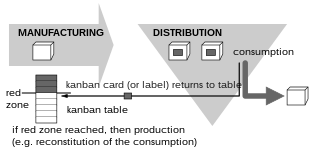Related Research Articles

In commerce, supply chain management (SCM), the management of the flow of goods and services, between businesses and locations, and includes the movement and storage of raw materials, of work-in-process inventory, and of finished goods as well as end to end order fulfillment from point of origin to point of consumption. Interconnected, interrelated or interlinked networks, channels and node businesses combine in the provision of products and services required by end customers in a supply chain.
Material requirements planning (MRP) is a production planning, scheduling, and inventory control system used to manage manufacturing processes. Most MRP systems are software-based, but it is possible to conduct MRP by hand as well.

Kanban is a scheduling system for lean manufacturing. Taiichi Ohno, an industrial engineer at Toyota, developed kanban to improve manufacturing efficiency. The system takes its name from the cards that track production within a factory. Kanban is also known as the Toyota nameplate system in the automotive industry.
Vendor-managed inventory (VMI) is an inventory management practice in which a supplier of goods, usually the manufacturer, is responsible for optimizing the inventory held by a distributor.

Manufacturingresource planning is defined as a method for the effective planning of all resources of a manufacturing company. Ideally, it addresses operational planning in units, financial planning, and has a simulation capability to answer "what-if" questions and is an extension of closed-loop MRP.
The beer distribution game is an educational game that is used to experience typical coordination problems of a supply chain process. It reflects a role-play simulation where several participants play with each other. The game represents a supply chain with a non-coordinated process where problems arise due to lack of information sharing. This game outlines the importance of information sharing, supply chain management and collaboration throughout a supply chain process. Due to lack of information, suppliers, manufacturers, sales people and customers often have an incomplete understanding of what the real demand of an order is. The most interesting part of the game is that each group has no control over another part of the supply chain. Therefore, each group has only significant control over their own part of the supply chain. Each group can highly influence the entire supply chain by ordering too much or too little which can lead to a bullwhip effect. Therefore, the order taking of a group also highly depends on decisions of the other groups.
Demand management is a planning methodology used to forecast, plan for and manage the demand for products and services. This can be at macro-levels as in economics and at micro-levels within individual organizations. For example, at macro-levels, a government may influence interest rates to regulate financial demand. At the micro-level, a cellular service provider may provide free night and weekend use to reduce demand during peak hours.
Safety stock is a term used by logisticians to describe a level of extra stock that is maintained to mitigate risk of stockouts caused by uncertainties in supply and demand. Adequate safety stock levels permit business operations to proceed according to their plans. Safety stock is held when uncertainty exists in demand, supply, or manufacturing yield, and serves as an insurance against stockouts.
Inventory control or stock control can be broadly defined as "the activity of checking a shop's stock." It is the process of ensuring that the right amount of supply is available within a business. However, a more focused definition takes into account the more science-based, methodical practice of not only verifying a business' inventory but also maximising the amount of profit from the least amount of inventory investment without affecting customer satisfaction. Other facets of inventory control include forecasting future demand, supply chain management, production control, financial flexibility, purchasing data, loss prevention and turnover, and customer satisfaction.

The bullwhip effect is a distribution channel phenomenon in which demand forecasts yield supply chain inefficiencies. It refers to increasing swings in inventory in response to shifts in consumer demand as one moves further up the supply chain. The concept first appeared in Jay Forrester's Industrial Dynamics (1961) and thus it is also known as the Forrester effect. It has been described as “the observed propensity for material orders to be more variable than demand signals and for this variability to increase the further upstream a company is in a supply chain”.

Demand-chain management (DCM) is the management of relationships between suppliers and customers to deliver the best value to the customer at the least cost to the demand chain as a whole. Demand-chain management is similar to supply-chain management but with special regard to the customers.
Supply-chain optimization (SCO) aims to ensure the optimal operation of a manufacturing and distribution supply chain. This includes the optimal placement of inventory within the supply chain, minimizing operating costs including manufacturing costs, transportation costs, and distribution costs. Optimization often involves the application of mathematical modelling techniques using computer software. It is often considered to be part of supply chain engineering, although the latter is mainly focused on mathematical modelling approaches, whereas supply chain optimization can also be undertaken using qualitative, management based approaches.
Collaborative Planning, Forecasting and Replenishment (CPFR) is an approach which aims to enhance supply chain integration by supporting and assisting joint practices. CPFR seeks cooperative management of inventory through joint visibility and replenishment of products throughout the supply chain. Information shared between suppliers and retailers aids in planning and satisfying customer demands through a supportive system of shared information. This allows for continuous updating of inventory and upcoming requirements, making the end-to-end supply chain process more efficient. Efficiency is created through the decrease expenditures for merchandising, inventory, logistics, and transportation across all trading partners.

Build to Order is a production approach where products are not built until a confirmed order for products is received. Thus, the end consumer determines the time and number of produced products. The ordered product is customized, meeting the design requirements of an individual, organization or business. Such production orders can be generated manually, or through inventory/production management programs. BTO is the oldest style of order fulfillment and is the most appropriate approach used for highly customized or low volume products. Industries with expensive inventory use this production approach. Moreover, "Made to order" products are common in the food service industry, such as at restaurants.
Production leveling, also known as production smoothing or – by its Japanese original term – heijunka (平準化), is a technique for reducing the mura (unevenness) which in turn reduces muda (waste). It was vital to the development of production efficiency in the Toyota Production System and lean manufacturing. The goal is to produce intermediate goods at a constant rate so that further processing may also be carried out at a constant and predictable rate.
Sales and operations planning (S&OP) is an integrated business management process through which the executive/leadership team continually achieves focus, alignment and synchronization among all functions of the organization. The S&OP process includes an updated forecast that leads to a sales plan, production plan, inventory plan, customer lead time (backlog) plan, new product development plan, strategic initiative plan and resulting financial plan. Plan frequency and planning horizon depend on the specifics of the industry. Short product life cycles and high demand volatility require a tighter S&OP than steadily consumed products. Done well, the S&OP process also enables effective supply chain management.
Customer demand planning (CDP) is a business-planning process that enables sales teams to develop demand forecasts as input to service-planning processes, production, inventory planning and revenue planning.
In economics, an excess supply, economic surplus market surplus or briefly surply is a situation in which the quantity of a good or service supplied is more than the quantity demanded, and the price is above the equilibrium level determined by supply and demand. That is, the quantity of the product that producers wish to sell exceeds the quantity that potential buyers are willing to buy at the prevailing price. It is the opposite of an economic shortage.
Material theory is the sub-specialty within operations research and operations management that is concerned with the design of production/inventory systems to minimize costs: it studies the decisions faced by firms and the military in connection with manufacturing, warehousing, supply chains, spare part allocation and so on and provides the mathematical foundation for logistics. The inventory control problem is the problem faced by a firm that must decide how much to order in each time period to meet demand for its products. The problem can be modeled using mathematical techniques of optimal control, dynamic programming and network optimization. The study of such models is part of inventory theory.
In supply chain management, supply chain collaboration is defined as two or more autonomous firms working jointly to plan and execute supply chain operations. It can deliver substantial benefits and advantages to collaborators. It is known as a cooperative strategy when one or more companies or business units work together to create mutual benefits. There are two main types of supply chain collaboration: vertical collaboration and horizontal collaboration. Vertical collaboration is the collaboration when two or more organizations from different levels or stages in supply chain share their responsibilities, resources, and performance information to serve relatively similar end customers; while horizontal collaboration is an inter-organizational systemrelationship between two or more companies at the same level or stage in the supply chain in order to allow greater ease of work and cooperation towards achieving a common objective.
References
- ↑ Kumar, A.: Supply Contracts and Manufacturing Decisions, Graduate School of Industrial Administration, Carnegie Mellon University, Pittsburgh, PA, 15213, 1992.
- ↑ Tirole, J.: The Theory of Industrial Organization. MIT Press, 1988. ( ISBN 0-262-20071-6)
- ↑ Li, X., Wang, Q.: Coordination Mechanisms of Supply Chain Systems. Invited Review. European Journal of Operational Research, 179(1), pp. 1-16, 2007.
- ↑ Cachon, G.P.: Supply Chain Coordination with Contracts Archived 2010-06-21 at the Wayback Machine . In de Kok, A.G., Graves, S.C. (eds): Supply Chain Management: Design, Coordination and Cooperation. Handbooks in Operations Research and Management Science, 11, Elsevier, pp. 229-339, 2003. ( ISBN 0-444-51328-0)
- 1 2 3 Stadtler, H.: A Framework for Collaborative Planning and State-of-the-Art. OR Spectrum, 31, pp. 5-30, 2009.
- ↑ Albrecht, M.: Supply Chain Coordination Mechanisms Springer, 2010. ( ISBN 978-3-642-02832-8).
- ↑ Tsay, A. A., Nahmias, S., Agrawal, N.: Modeling Supply Chain Contracts: A Review. In: Tayur, S., Ganeshan, R., Magazine, M. (eds.): Quantitative Models for Supply Chain Management. International Series in Operations Research and Management Science, 17, Kluwer Academic Publishers, pp. 299-336, 1999. ( ISBN 0-792-38344-3)
- ↑ Egri, P.: Coordination in production networks. PhD Thesis, Eötvös Loránd University, Budapest, 2008.
- ↑ Sethi, S.P., Yan, H., Zhang, H.: Inventory and Supply Chain Management With Forecast Updates. Springer, 2005. ( ISBN 1-402-08123-5 )
- ↑ Altintas, N.; Erhun, F.; Tayur, S. (2008). "Quantity Discounts Under Demand Uncertainty". Management Science. 54 (4): 777–792. doi:10.1287/mnsc.1070.0829.
- ↑ Scheller-Wolf, A., Tayur, S.: Reducing international risk through quantity contracts. Carnegie Mellon University Graduate School of Industrial Administration Working Paper, 1997.
- ↑ Erhun, F.; Keskinocak, P.; Tayur, S. (2008). "Dynamic procurement in a capacitated supply chain facing uncertain demand". IIE Transactions. 40 (8): 733–748. doi:10.1080/07408170701744827. S2CID 123176518.